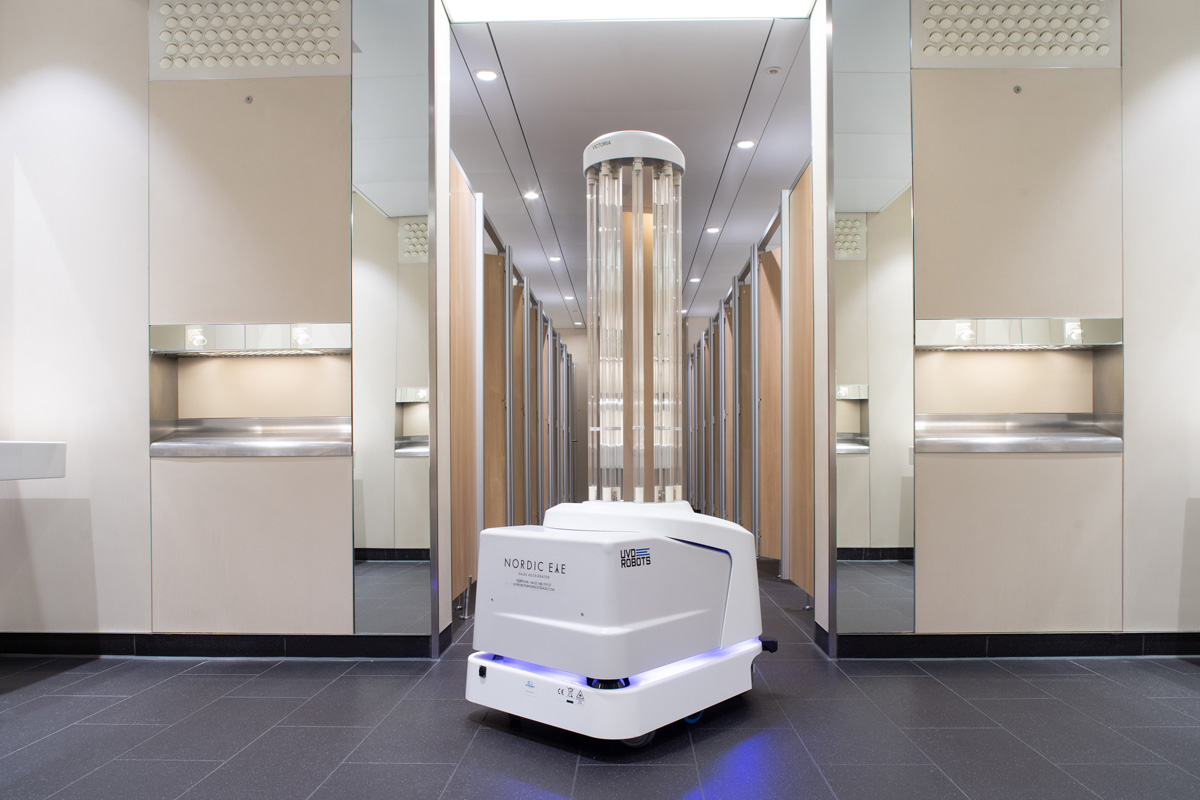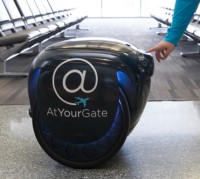Up to date information of industry news coverage
News Coverage from around the world
UVD Robots delivers robot # 100 of 200 to EU hospitals
September 22, 2021
ODENSE, Denmark--
PRESS RELEASE HERE
This week, Consorci Corporació Sanitari Parc Taulí hospital in Barcelona, Spain received the UVD Robot no. 200 donated via the European Commission’s Emergency Support Instruments.
In the last couple of years, the corona virus has caused a huge impact all across Europe. UVD Robots and Blue Ocean Robotics - the manufacturer of the autonomous disinfecting robot equipped with UV-C light - was selected by the European Commission, as a supplier for its autonomous disinfection robots to European Union hospitals in the fight against SARS-CoV-2 known as Coronavirus. (video below)
June 29, 2021
ODENSE, Denmark--PRESS RELEASE HERE
UVD Robots and Blue Ocean Robotics, the manufacturer of autonomous disinfecting robots equipped with UV-C light, UVD Robots Deploys Robot number 100 Ordered by EU in Hospitals Across Europe
See full story below
UVD Robots Wins EU Contract to Deploy 200 Robots in Hospitals Across Europe
December 07, 2020 09:02 AM Eastern Standard Time
ODENSE, Denmark--(BUSINESS WIRE)--UVD Robots and Blue Ocean Robotics, the manufacturer of autonomous disinfecting robots equipped with UV-C light, announced today that it was selected by the European Commission directorate-Generale for Communications Networks, Content and Technology (EU Commission) to supply 200 of its autonomous disinfecting robots to European Union hospitals fighting the Coronavirus.
UVD Robots’ tender RANKED FIRST in the EU Commission’s review of disinfecting robots evaluating technical excellence and maturity of technology, quality of approach in deployment, response time in technical support and maintenance, and overall value. UVD Robots are now being deployed in the first 10+ EU countries with more to follow.
"With EU funds, the European Commission is buying 200 disinfection robots, which will be delivered to hospitals across Europe to help clean patient rooms. We do all we can to support hospitals and patients in these difficult times. And more will follow."
Ursula von der Leyen, President of the European Commission
 EU ANNOUNCEMENT - click for details
EU ANNOUNCEMENT - click for details
LATEST NEWS FEEDS...
EU INCREASES ORDER TO 300
Brussels September 21, 2021 
Coronavirus: 200th EU disinfection robot delivered to European hospital, a further 100 confirmed
Today, the Commission delivered the 200th disinfection robot – to Consorci Corporació Sanitària Parc Taulí hospital in Barcelona. The robots, donated by the Commission, help sanitise COVID-19 patient rooms and are part of the Commission's action to supply hospitals across the EU to help them cope with the effects of the coronavirus pandemic. Further to these initial 200 robots announced in November last year, the Commission secured the purchase an additional 100, bringing the total donations to 300. Executive Vice-President for a Europe fit for the Digital Age, Margrethe Vestager, said: “Assisting Member States overcome the challenges of the pandemic continues to be a number one priority and these donations – a very tangible form of support – are a prime example of what can be achieved. This is European solidarity in action and I am pleased to see the Commission can go the extra mile in donating an additional 100 disinfection robots to hospitals in need.”
DELTA VARIANT:
CBC NEWS June 11, 2021 
Delta variant worries grow in Alberta as rollout of 2nd COVID vaccine doses accelerates
As Alberta speeds up rollout of second COVID-19 vaccine doses, concerns are mounting about a small but growing number of cases of the more infectious delta variant, and questions are emerging about the level of protection vaccines offer and which second dose is best for those who have a choice..
Robot workforce:
May 2021
AIRPORT INDUSTRY REVIEW

Robots are an additional measure within our process that help to keep Heathrow Airport Covid-secure.
Cleaning robots are also having their day. Heathrow Airport has been using cleaning robots around the airport terminals and lounges that disinfect areas using ultraviolet (UV) light, which has been shown to efficiently kill harmful viruses and bacteria to provide a safe, secure environment for passengers.

Airports are developing robot workers to tirelessly serve passengers
PHL Food & Shops, the concessions programme at Philadelphia International Airport, is piloting a contactless ordering system featuring robotic food delivery.
BREAKING NEWS...
First EU disinfection robots arrive in hospitals across Europe
Feb 26, 2021 EUROPEAN COMMISSION 

BREAKING NEWS...
World Health Organisation (WHO) report calls for urgent action to avert antimicrobial resistance crisis.
29 April 2019 - Joint News Release - New York 
UN, international agencies and experts today released a groundbreaking report demanding immediate, coordinated and ambitious action to avert a potentially disastrous drug-resistance crisis.
If no action is taken - warns the UN Ad hoc Interagency Coordinating Group on Antimicrobial Resistance who released the report – drug-resistant diseases could cause 10 million deaths each year by 2050 and damage to the economy as catastrophic as the 2008-2009 global financial crisis. By 2030, antimicrobial resistance could force up to 24 million people into extreme poverty.
BREAKING NEWS...
COVID-19: B.C. Centre for Disease Control now accepts virus can linger in the air
May 6, 2021 - Vancouver, BC VANCOUVER SUN - David Carrigg

Until now, the Centre had stated the disease spreads only through large droplets. That means the threat of catching COVID-19 isn’t only from large, virus-laden droplets that fall to the ground, but from small particles that can linger in the air for hours, building up in poorly ventilated indoor spaces, while quickly dispersing outdoors. Therefore the size of an indoor space, how many people are in it, the length of exposure and air circulation all factor into how easily viral particles might spread. The Centre states the risk of transmission of the disease by touching surfaces is very low.
BREAKING NEWS ON SURFACE TRANSMISSION...
March 2022
The scientists found that severe acute respiratory syndrome coronavirus 2 (SARS-CoV-2) was detectable in aerosols for up to three hours, up to four hours on copper, up to 24 hours on cardboard and up to two to three days on plastic and stainless steel. The team found Omicron "is more stable than the ancestral SARS-CoV-2 on different surfaces." "Our findings imply that (Omicron) has an increased likelihood to be transmitted by the fomite or surface route," the researchers concluded.
FULL REPORT: New Omicron coronavirus stable for hours on surfacesDec 13 2020

STATES TOUCHING SURFACES 3rd HIGHEST RISK OF TRANSMISSION. CORONAVIRUS DISEASE
(COVID-19): HOW IS IT TRANSMITTED / How does Covid-19 spread?
SURFACE SURVIVAL
CDC,NHL,WHO

Updated April 5, 2021
Centre for disease Control and Prevention indicates on non-porous surfaces
the virus can survive for weeks:
Science Brief: SARS-CoV-2 and Surface (Fomite) Transmission for Indoor Community Environments
Numerous researchers have studied how long SARS-CoV-2 can survive on a variety of porous and non-porous surfaces. On porous surfaces, studies report inability to detect viable virus within minutes to hours; on non-porous surfaces, viable virus can be detected for days to weeks. The apparent, relatively faster inactivation of SARS-CoV-2 on porous compared with non-porous surfaces might be attributable to capillary action within pores and faster aerosol droplet evaporation
Data from surface survival studies indicate that a 99% reduction in infectious SARS-CoV-2 and other coronaviruses can be expected under typical indoor environmental conditions within 3 days (72 hours) on common non-porous surfaces like stainless steel, plastic, and glass. When accounting for both surface survival data and real-world transmission factors, the risk of fomite transmission after a person with COVID-19 has been in an indoor space is lower after 3 days (72 hours), regardless of when it was last cleaned.

Updated Sept 2021
In its internal Covid protocol document the NHL MANDATES that hockey clubs must:
- Clubs shall provide face coverings, hand sanitizer and disinfectant wipes to all members of the Travelling Party, shall travel with additional supplies while on the road, and shall have on hand an adequate overall supply of these products prior to Club travel.
- All members of the Travelling Party shall frequently clean and/or disinfect their hands and high touch surfaces they encounter in connection with Club Travel (e.g., when entering the Club hotel, Club facilities, planes and buses; luggage handles; hotel key cards; remote controls; phones; airplane seatbelts; trays on airplanes; etc.).
- Clubs shall ensure that all travel partners (hotels, airlines, buses) have adopted enhanced cleaning and disinfecting protocols, consistent with industry standard and best practices, which include, without limitation, frequent disinfecting of “high touch” facilities, rooms, surfaces, etc., with hospital-grade EPA List N disinfectants or Health Canada approved products. Disinfection shall occur before and after each usage by the Club.
- In-flight catering, including distribution and clean-up of food and beverage, shall be as limited as possible to avoid touch points and interactions between flight attendants and members of the Travelling Party. Single-use utensils, napkins, plates, condiments, and hand wipes shall be provided for and disposed of after each meal.
- The buses shall be cleaned and disinfected before and between each time the Club Travelling Party reboards the bus during trips

Updated October, 2021
The World Health Organisation
on surface transmission:
Science Brief: SARS-CoV-2 and Surface (Fomite) Transmission for Indoor Community Environments
The World Health Organisation (WHO) advises that the virus can also spread in crowded indoor settings, where people tend to spend longer periods of time. This is because aerosols remain suspended in the air or travel farther than 1 metre (long-range). And that people may also become infected by touching surfaces that have been contaminated by the virus when touching their eyes, nose or mouth without cleaning their hands:
more details and full article







